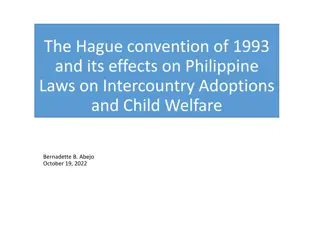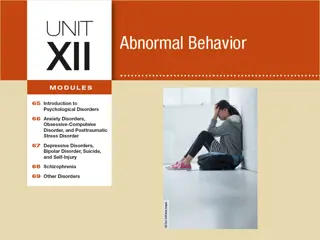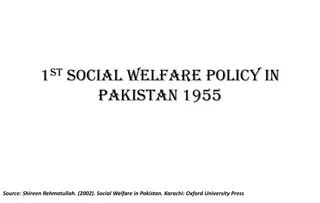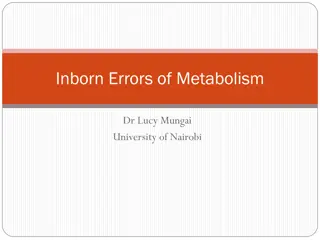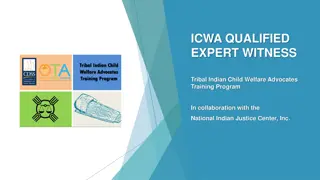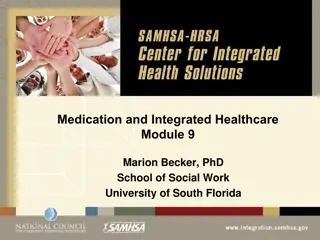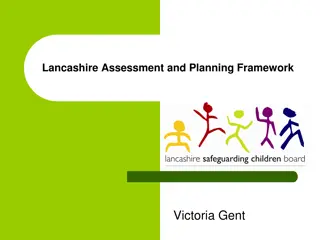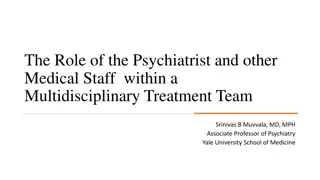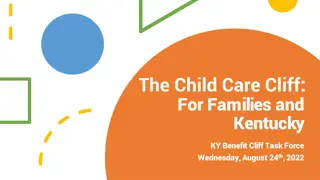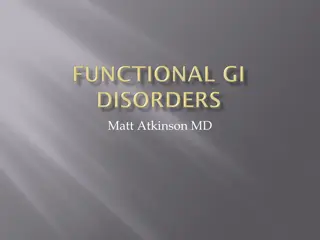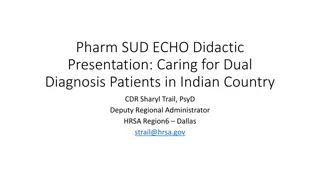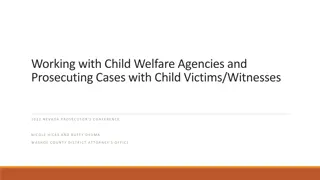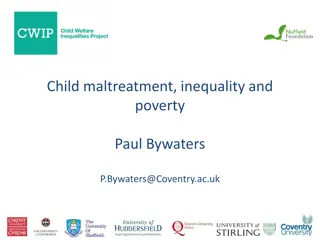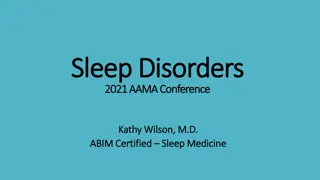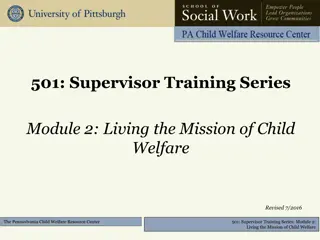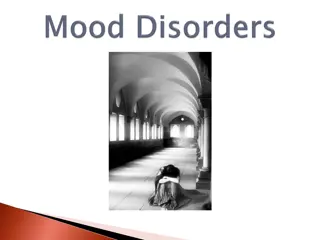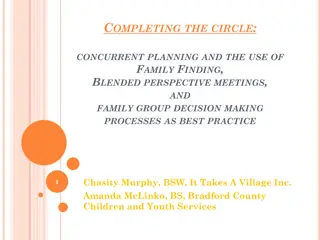Understanding Co-Occurring Disorders in Child Welfare Training
This module delves into the complexities of co-occurring substance use disorders, mental health/trauma issues, and domestic violence within the child welfare system. It covers identifying various mental health disorders, recognizing signs of co-occurring disorders, understanding the impact of trauma, addressing domestic violence, and engaging families in treatment and recovery. The content emphasizes collaborative values, dispels stigma related to addiction, and stresses the continuum of mental health conditions that vary among individuals.
Download Presentation

Please find below an Image/Link to download the presentation.
The content on the website is provided AS IS for your information and personal use only. It may not be sold, licensed, or shared on other websites without obtaining consent from the author. Download presentation by click this link. If you encounter any issues during the download, it is possible that the publisher has removed the file from their server.
E N D
Presentation Transcript
Module 3: Understanding Co-Occurring Substance Use Disorders, Mental Health/Trauma, and Domestic Violence Child Welfare Training Toolkit
Acknowledgment A program of the Substance Abuse and Mental Health Services Administration (SAMHSA) and the Administration for Children and Families (ACF), Children s Bureau www.ncsacw.samhsa.gov | ncsacw@cffutures.org
Learning Objectives After completing this training, child welfare workers will: Identify the spectrum and types of mental health disorders Recognize signs and symptoms of co-occurring and mental health disorders Explain the effect of trauma on co-occurring disorders Recognize domestic violence in the child welfare population Recognize the effects of co-occurring and mental health disorders on interpersonal relationships and parenting Engage with families to identify co-occurring and mental health disorders Understand treatment effectiveness and recovery from co-occurring disorders
Collaborative Values Inventory Neutral or Unsure Strongly Disagree Strongly Agree Disagree Agree A parent with co-occurring mental health issues must first receive mental health treatment before substance use disorder treatment can work Parents with substance use disorders often fail to complete treatment because they face real barriers such as poverty, mental illness, family violence, or transportation challenges The stigma associated with addiction prevents parents from seeking treatment (Children and Family Futures, 2017)
Mental Health Disorders
Mental Health Many terms may be used, such as "mental illness," "mental health problems," or "behavioral disorders" Each disorder is different in each person There is no "have it" or "don t have it" Mental health is a continuum or spectrum Mental health disorders vary from person to person and from time to time
Effects of Mental Health Disorders Thought processes, moods, and emotions are affected by mental health disorders Mental health disorders are biologically based Effects on an individual s life are important to consider Disorders can vary in severity, and their severity may change over time Cause is less important than current severity Violence is not associated with all disorders (National Institutes of Health, 2007)
Types of Mental Health Disorders Schizophrenia spectrum and other psychotic disorders Bipolar disorder and related disorders Depressive disorders Anxiety disorders Obsessive-compulsive and related disorders Trauma- and stressor-related disorders Dissociative disorders Somatic symptom and related disorders (American Psychiatric Association, 2013)
Co-Occurring Disorders Mental health disorder Substance use disorder Co- occurring disorders
Effect of Trauma Adverse Childhood Experiences (ACE) score Trauma increases risk for mental health and substance use disorders Parents learn to parent from their parents Childhood trauma affects parenting Child abuse sometimes crosses generations (Center for Substance Abuse Treatment, 2000)
Trauma and Families Parents with substance use disorders often have a history of trauma, with 60% to 90% of treatment participants having experienced one or more traumatic events Early traumatic events, such as exposure to family violence and physical abuse, can lead to a greater risk of developing posttraumatic stress disorder, which has been shown to significantly increase the likelihood of a substance use disorder among older youth in foster care Families affected by substance use disorders who are involved in the child welfare system need a system of care that recognizes the effect of trauma on their functioning and recovery Evidence-based trauma services should be provided within the context of an organizational culture that avoids triggering or unintentionally re-traumatizing both parents and children In a trauma-informed organization, every part of the organization from management to service delivery has an understanding of how trauma affects the life of an individual seeking services (Center for Substance Abuse Treatment, 2000; Dube et al., 2002; Felitti et al., 1998; Greeson et al., 2011)
Effects of Trauma Attachment and relationships Physical health: body and brain Emotional responses Dissociation Behavior Cognition: thinking and learning Self-concept and future orientation Economic impact (Levenson, 2017; Substance Abuse and Mental Health Services Administration, 2014)
Importance of Trauma-Informed Care Failure to identify and address trauma may lead to: Withdrawal from services Inadequate or inappropriate services Re-traumatization Increase in relapse events Increase in management problems Poor treatment outcomes Before assuming a client is being "non-compliant," think trauma first (Levenson, 2017)
Importance of Trauma-Informed Care High prevalence of trauma, substance use, and mental health disorders in families involved with child welfare Traumatic events shatter trust; the experiences that a client has from the moment he or she arrives will affect his or her ability to engage in the healing process Need to maximize safety and reduce possible re-traumatization of clients Trauma-informed services improve retention in services and improve outcomes (Levenson, 2017)
Six Principles of Trauma-Informed Care 1. Safety Ensure the physical and emotional safety of clients and staff 2. Trustworthiness and Transparency Provide clear information about what the client may expect in the program; ensure consistency in practice and maintain boundaries 3. Peer Support Provide peer support from people with lived experiences of trauma to establish safety and hope and build trust 4. Collaboration and Mutuality Maximize collaboration and sharing of power with consumers to level power differences between staff and clients 5. Empowerment, Voice, and Control Empower clients and staff to have a voice and share in decision-making and goal setting to cultivate self-advocacy 6. Cultural, Historical, and Gender Issues As an organization, move past cultural stereotypes and biases, offer gender and culturally responsive services, and recognize and address historical trauma (Substance Abuse and Mental Health Services Administration, 2014)
Prevalence of Domestic Violence More than 1 in 3 women and 1 in 4 men have experienced at least one form of violence (sexual violence, physical violence, or stalking) by an intimate partner in their lifetime Approximately 1 in 4 women and 1 in 7 men have experienced severe physical violence by an intimate partner Nearly 1 in 10 women have been raped by an intimate partner in their lifetime Nearly half of all men and women reported psychological abuse by an intimate partner The prevalence of domestic violence among individuals who identified as gay and lesbian was similar to and higher than, respectively, the prevalence of domestic violence among individuals who identified as heterosexual The prevalence of domestic violence among individuals who identified as bisexual was higher than that of gay, lesbian, and heterosexual identifying individuals Nearly one-quarter of survivors first experienced domestic violence before age 25 (Thomas et al., 2017; National Institute of Mental Health, 2017; Smith et al., 2018)
Childrens Exposure to Domestic Violence At least 10% to 20% of children are exposed to domestic violence annually, a disproportionate number of whom are under the age of 6 Exposure to domestic violence can include hearing, witnessing, and intervening during an incident as well as witnessing the impact on the mother after the incident Children may also become targets of violence during a domestic violence incident or may experience ongoing abuse themselves (Thomas et al., 2017)
Domestic Violence Terminology 1. Domestic violence 2. Survivor 3. Safer 4. Person who uses abusive behaviors 5. Intimate partner 6. Intimate partner violence (Thomas et al., 2017)
Guidelines for Working with Families Affected by Domestic Violence Be aware of your own cultural and personal assumptions about domestic violence and how that might affect your interactions with the people with whom you work Be aware of how your gender, race, culture, and role may affect the experience of the people with whom you work Be aware that violence rarely presents itself in people s lives independent from other problems Provide a safe place for people to seek support, recognizing that people may feel safe in different types of places and contexts Advocate for people s needs within and outside your agency Act as an ally to survivors with whom you work Practice self-care Provide appropriate information and referrals (Thomas et al., 2017)
Screening for Domestic Violence Safety needs to be considered before engagement Each person should be interviewed alone Don t make false assumptions Consider what information you have and what you need to know Build rapport through general questions and building on strengths Use follow-up questions and remember to listen (Thomas et al., 2017)
Domestic Violence and Child Welfare Assess protective factors Assess risk factors Use a trauma-informed approach Conduct safety planning (Thomas et al., 2017)
Childrens Experiences of Domestic Violence Children can experience domestic violence in multiple ways. Some of the ways they can experience domestic violence include: Being in the home (or nearby) and hearing the abusive incident occurring Witnessing the direct aftermath of an incident Sensing the fear and anxiety of the abused parent (or caretaker) Feeling generally unsafe in the home Being used as a tool to control the survivor Being used indirectly as a tool to manipulate and control a survivor Being the indirect or direct targets of physical violence (Thomas et al., 2017)
Womens Experiences of Co-Occurring Disorders, Trauma, and Domestic Violence Domestic Violence Women using substances are more likely to become victims of domestic violence Victims of domestic violence are more likely to become dependent on tranquilizers, sedatives, stimulants, and painkillers, and are more likely to misuse alcohol Co-Occurring Disorders Childhood abuse and neglect may contribute to anxiety, depression, PTSD, dissociative disorders, personality disorders, self-mutilation, and self-harming in adults Among individuals with substance use problems, more women than men have a second diagnosis of a mental health disorder (Center for Substance Abuse Treatment, 2014; Mason & O Rinn, 2014)
Case Vignette Mother s name: Ginny Stepfather s name: Harold Children s names: Charles (13), Gina (9), Lenny (6) Family ethnicity: Caucasian Ginny (35) is recently married to Harold (42). She has three children from two previous relationships, including a relationship with a man who was jailed for violence against her and her children. Charles has been in a residential facility after his behavior was found to be too disruptive for school. Gina is very quiet, staying close to her mother. Lenny has boundless energy and rarely sits down. Ginny has a past diagnosis of depression and posttraumatic stress disorder. She smokes marijuana, because she says it helps her stay calm. Lenny is starting to show disruptive behaviors at school, similar to Charles past behaviors. The school has filed a report because Ginny has not come to several meetings set up by the school.
Case Activity What are your concerns? What information do you want to gather? How would you use a trauma-informed approach to meet with Ginny s family?
Effects of Trauma and Mental Health Disorders on Children
Risk Factors for Children Exposure to violence and trauma Poverty Neglect Housing and custodial instability Mental health and substance use disorders Developmental delays Stigma and isolation Parentification (National Abandoned Infants Assistance Resource Center, 2012)
Effect of Parental Substance Use and Co-Occurring Disorders on Children Delayed development: Understand how the environment disrupts physical, emotional, social, or educational development Child s needs: Work with substance use disorder and mental health treatment professionals Educate: Help children understand substance use and mental health disorders in nonjudgmental and supportive terms (define the disorder, not the person) (National Abandoned Infants Assistance Resource Center, 2012)
Effects of Trauma on the Child Executive functioning problems, inability to self- regulate and to generalize across situations Gross and fine motor delays Attention problems Memory difficulties Attachment disorders Children of parents with substance use disorders are at an increased risk of developing their own substance use and mental health disorders (Calhoun et al., 2015)
Building Rapport Acknowledging the power differential Establishing a relationship Explaining the process Screening for substance use, mental health disorders, and domestic violence (Storer et al., 2012)
Engaging Parents in Treatment: A Continuous Process Child welfare workers: Screen parents for potential substance use or mental health disorders Motivate parents to engage in and remain in treatment Help parents to sustain recovery Do not wait for substance use treatment or mental health disorder treatment to begin before other interventions occur (Wells et al., 2015)
Enhancing Parent Motivation Encourage parents to seek treatment: Work with attorneys and courts Encourage parents to stay in treatment: Respond appropriately to relapse Support sustained recovery Help parents understand dependency court requirements Assure parents that children are safe and in good care (Geiger, 2017)
Engaging Parents in Treatment Models and Strategies Using motivational enhancement strategies: Help parents and children identify their needs Develop rapport and build trust with parents Recognize and affirm positive behaviors Ensure frequent and safe visitation, as appropriate This is vital for both children and parents Do not use as a reward or punishment (Randolph et al., 2009)
Engaging With Children Affected by Domestic Violence Respond to the child in a calm and supportive way Seek supervision or consultation Create a safety plan with family members and children when age appropriate Provide emotional support Provide social support (Thomas et al., 2017)
Case Activity: Ginny and Harold Very little is known about Harold. He doesn t answer questions and does not want to be involved with child welfare. Ginny has used domestic violence services in the past but never follows through for long. Ginny states that smoking marijuana is more effective than counseling for dealing with her depression. Ginny s mother lives down the street from the family and will pick the children up at school most days. Ginny attends all of the meetings at Charles residential program and is excited that he is returning home. Ginny is working part-time as a receptionist at an insurance company.
Case Activity: Next Steps List the protective and risk factors for the family. What engagement strategies would you use when working with Ginny? What services would you consider for Ginny, Harold, and the children?
Assessment of Mental Health Disorders
Mental Health Disorder Assessment Conducted by qualified mental health professionals Based on the Diagnostic & Statistical Manual of Mental Disorders, Fifth Edition (DSM-5) outlines criteria for each diagnosis Diagnosing mental health disorders is not exact Trauma and stressor-related disorders can be diagnosed and treated Some people receive multiple, appropriate diagnoses, and diagnoses change over time (Thagard & Larocque, 2018)
Mental Health Disorder Assessment Outcomes What you might expect to receive: A diagnosis Multiple diagnoses Treatment recommendations related to the diagnosis Recommendations for further assessment Recommendations for other service agencies
Co-Occurring Substance Use and Mental Health Disorders A co-occurring disorder is the co-existence of both a mental health and a substance use disorder People with mental health disorders are more likely to experience a substance use disorder Symptoms can be complex and hard to diagnose Symptoms of each disorder can vary in severity It is important to identify and treat both disorders through integrated treatment (Padwa et al., 2015)
Assessment of Co-Occurring Disorders Three possible paths: 1. One person assesses for both a substance use and mental health disorder 2. Assessment of substance use disorder leads to referral and assessment for a mental health disorder 3. Assessment of mental health disorder leads to referral and assessment for a substance use disorder Some treatment professionals are cross-trained to conduct both assessments, actively looking for co-occurring disorders (Darghouth et al., 2012)
Co-Occurring Disorders and Case Planning Include diagnoses, level of care, and treatment plan(s) Address social, economic, motivational, or other issues Engage the Collaborative Team treatment and child welfare workers and relevant family and friends Resolve conflicting treatment messages (Darghouth et al., 2012)
Treatment and Supports for Co-Occurring Mental Health Disorders and Domestic Violence
Co-Occurring Disorder Treatment Integrated: Both disorders are treated at the same time by the same treatment provider Parallel: Both disorders are treated at the same time but by different providers Sequential: One disorder is treated at a time (Substance Abuse and Mental Health Services Administration, 2005)
Interventions for Co-occurring Mental Health Disorders Medication Self-help groups Education for client and family Care or case management Counseling Day treatment Respite care Residential treatment Peer support Hospitalization (Mueser et al., 2009; Subodh et al., 2018)
Domestic Violence Resources Domestic violence hotlines Domestic violence community-based and residential programs Community-based services Domestic violence residential services: shelters and transitional living programs Emergency homeless shelter system Family shelters Shelters for individuals (a.k.a. unaccompanied adults) Hospitals and health centers (Thomas et al., 2017)








